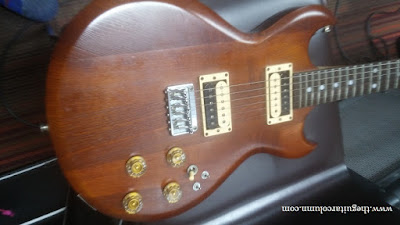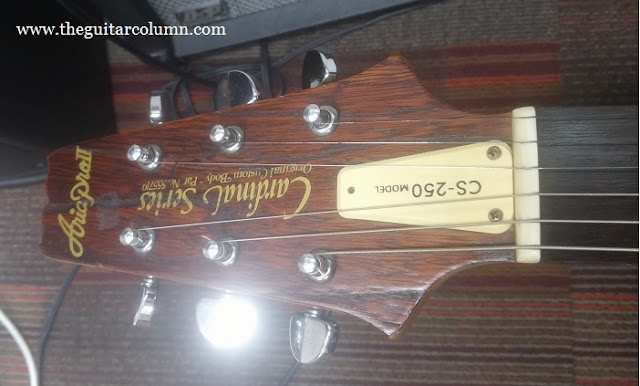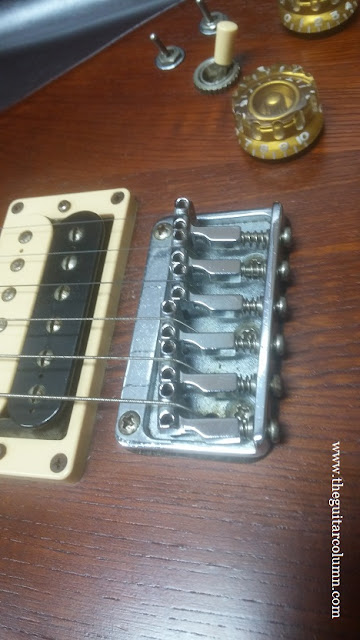A few weeks ago my good buddy Eric forwarded a couple pics of this Aria Pro II CS 250 from the early 80's that he happened to see at a local rehearsal studio. My response was the usual "Cool guitar, man. Go for it!".
I forgot all about it until last week when Eric and I met up for lunch and our usual Thursday afternoon jaunt to our favorite local music store. Eric needed to buy a guitar stand and the ones we saw on sale were way overpriced for some reason. Long story short, we ended at up at the same rehearsal studio where Eric had seen the Aria a few weeks before.
I remember the Aria Pro II Cardinal Series as being the most ubiquitous of the budget guitars back in the day. A step below the 'lawsuit' Ibanezes and Grecos that were going for $300 to $350 Singapore dollars, new and used in the late 70's and early 80's, the Aria Pro II CS-250's were about $200 retail.
The price as I recall, matched the model number -- common practice amongst some Japanese guitar manufacturers. In Japan, the CS-250 might have had a suggested retail price of ¥25,000.
 |
| Aria Cardinal Series CS-250 in Walnut finish |
When Eric sent me the pictures he had taken of this guitar I wasn't overly impressed. But when I actually held it in my hands I realized that it was in amazing condition for a guitar that was made in the early '80s. Other than a small ding on the lower horn and rusty pickup mounting screws, this guitar was in excellent shape. There was hardly any wear on the frets and the headstock was devoid of any dings or chipped paint that are commonly seen on guitars of this age.
 |
| Beautifully grained Ash wood veneer over the headstock face |
And did I mention that it was just dripping with vibe?
If you read one of my earlier articles, How To Choose A Guitar That's Right For You, I mentioned that if a guitar seems to scream 'take me', then that was the guitar for you. This was indeed one of those rare moments.
And all for $250, including original hardcase!
A Bit Of Aria History
Arai & Co., Inc. was an import company founded by classical guitarist Shiro Arai in the early 50's, In 1956 they began retailing acoustic and classical guitars and in 1964, Arai commissioned Matsumoku, a prominent musical instrument factory, to build acoustic guitars. By 1966 the first Arai, Aria and Diamond electric guitars were born. Arai had decided that Aria would be a more suitable, musical sounding name for the international market.
And target the international guitar market they did, with their budget, bolt-on neck copies of the Gibson Les Paul in 1969. More copies of other Gibson models, along with Fender and Ampeg guitars soon followed.
By the early 70's, American guitar manufacturers had begun to notice the outstanding sales of the Japanese copy guitars and basses, and Cease and Desist letters were sent to US importers of these instruments, hence the term 'lawsuit-era guitars'.
Aria's answer to the ban on the import of their copy guitars were the Aria Pro II models which they built at the Matsumoku factory starting in 1975. Instruments from this period are sometimes referred to as 'Matsumoku Era', since the Matsumoku factory stopped building guitars in 1987.
The CS or Cardinal Series began production in 1981 and comprised of the CS-200, CS-250, CS-300, CS-350, CS-400, CS-Deluxe and CS-Custom models. Only the CS-400 and CS-Custom featured set-in necks, with the other models being bolt-ons.
Aria Pro II CS-250 Features
The Cardinal Series was Aria's attempt at producing an original design after their 'lawsuit' Gibson and Fender copy guitars could no longer be distributed in the US. Since they were up against established American brands, Aria was determined to make their guitars both more affordable and more versatile.
 |
| Aria's Accurate Bolt-On System neck joint. Notice 3-piece maple neck |
The Cardinal Series' take on Gibson's three-a-side headstock featured a straighter string pull over the nut for better tuning stability while the bolt-on versions featured what Aria proudly proclaimed to be their Accurate Bolt-On System. Aria's bolt-on maple necks sit snugly in a deep neck pocket that held the neck firmly, without any possibility of any side to side movement. With Fender's bolt-on design, a hard bump could instantly misalign the neck in the neck pocket necessitating the loosening of the bolt screws and realigning the neck.
Why Aria never licensed out their Accurate Bolt-On System we'll never know. It surely makes a bolt-on have the tone and sustain of a set neck at least, without losing that snap and bite you can only get with a bolt-on.
 |
| Deep pocket neck joint of the Accurate Bolt-On System |
Electronically, the CS-250 really excels. The two Protomatic IV humbuckers are wired to coil-tap and phase reversal switches so that the player could get more sounds out of the two humbucking pickups. The coil-tap switch sets both pickups to single coil mode while the phase switch works only when the pickup selector switch is set to the center position, both pickups on. The effect of the phase reversal switch is very subtle but the coil-tap instantly drops the output of the humbuckers and provides a very clean, thinner sound. Not exactly Strat-like by any stretch of the imagination, but handy for funky rhythms and twangy lead lines.
One problem is remembering what these switches do, especially if one hasn't played this guitar in a while!
 |
| Coil tap and phase reversal switches on the CS-250 |
For the bolt-on Cardinal Series, Aria chose to go with 3-piece maple necks, with the center piece set in a reverse grain from the outer two pieces. Other than being a cost cutting measure -- smaller pieces of wood could be glued together and cut -- it also made for a more stable neck than if it were made out of a single piece of maple.
Aria Pro II CS-250 Features List:
Aria Pro II CS-250 Features List:
- Ash body with contoured edges
- 3-piece maple neck, rosewood fingerboard, 22 frets
- 630 mm scale length (Gibson scale)
- Protomatic IV humbucking pickups with cream/black bobbins
- Two volume and two tone controls
- Mini toggle switches for coil cut and phase reversal (phase switch only works when both pickups are on)
- Through-body strung die-cast bridge
- Walnut matte finish (Padouk Red was the other finish option)
Feel-wise, the Aria Pro II CS-250 is a lot like a double cutaway Gibson Les Paul Junior -- small and compact -- although the roar and sustain from the twin humbuckers make it anything but. Those Protomatic IV pickups have some serious output and are one of the loudest pickups I've encountered. The neck pickup was especially loud and tended to overshadow the bridge pickup.
Setting it further away from the strings and bringing the bridge pickup up as close as it would go without touching the strings helped to even them out.
Setting it further away from the strings and bringing the bridge pickup up as close as it would go without touching the strings helped to even them out.
 |
| Zebra coils of the Protomatic IV pickups |
The neck of this particular guitar is adjusted nearly straight, with minimal neck relief, just how I like it. However, my attempt at turning the truss rod either way to see if it was working proved futile. It was tight as can be and refused to budge out of the position its held for the last 30-something years. Rather than risk breaking anything, I decided to not force it. Leave well enough alone, I always say.
On close examination, I noticed the die-cast, string-through-body bridge had one of the most unusual -- and original -- saddle designs on any guitar I've seen. Rather than the usual, rectangular saddle blocks, the Cardinal Series' taper from the two height adjustment screws to a single 'lug' that attaches to the intonation screws. This design cuts down on the mass of the saddle by about half! Beyond aesthetics, I cannot be certain how this actually affects the tone.
 |
| Unusual saddle design on Aria's die-cast bridge |
I feel that the CS-250 would benefit from having a set of 009-.042 strings installed, instead of the .010-.046 set I decided on. Beyond the string tension aspect, I think that a set of 9's would show off the tonal variations of the coil tap and phase reversal switches a little better. To my ears, true single coils and coil tapped humbuckers 'sparkle' a little bette with .009 gauge strings.
According to Aria authority site matsumoku.org, the Aria Pro II Cardinal Series was produced from 1981 to 1983, making this guitar at least 33 years old as of this writing!


No comments:
Post a Comment